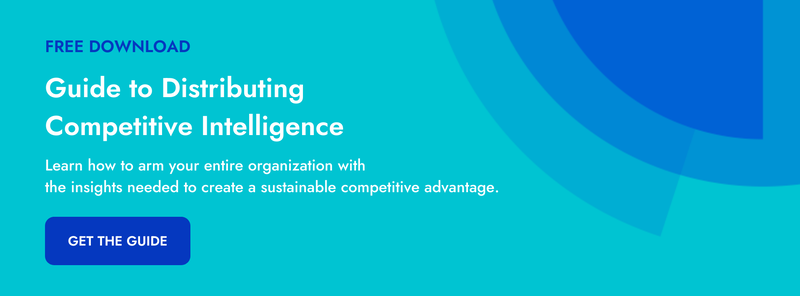If you’re like thousands of marketers across the globe, you want to shake up your headache-inducing competitive intelligence program and create a new approach. Maybe this year you got the coveted headcount for a role completely dedicated to it. Maybe it’s an ‘OKR’ for you or your team among many others. Maybe last year you got some ideas together, but that initial work is sitting in the intern’s Google Drive.
No matter what your situation is, there are some common communications traps and pitfalls you can avoid. Here’s a high-level look at those and some new ways to rethink old school CI techniques.
Common Trap #1: Your insights are stuck in one-off emails to Sales

Email is a quick and easy way distribute content and knowledge out to your sales team. At a startup, this might work in the beginning. But, the average office worker receives 100+ emails per day1. If your Competitive Intelligence is static and reactionary, and only visible to one function in your organization, you’ve limited the ability to get ahead. This approach will make it challenging to establish CI as a strategic pillar of the business and provide visibility for your contributions.
What you can do: Be more than an answer desk for Sales. Learn how your company communicates, and how your front-line field reps consume internal content. Take the plan beyond Sales. That reactionary support for sales to manage the ‘competitive battle’ while important, needs to extend across the business. If it hasn’t been established, determine the purpose, scope, and tools of what you plan to bring to the business. Start, by getting out of the reactionary habits and continue by mapping out a clear charter of how to continuously provide and communicate CI insights. Determine which functions need input, on what cadence, and in what format.
Common Trap #2: A well-maintained intranet page = strategy

‘But at least we got out of email!' you say. Your content repository, wherever it may be, is siloed information that stands alone. It just lacks any real-time context. Plus, you know you’ve got busy sales reps, product leaders, engineers, and marketing managers. Unless they don’t have enough work on their plate, they probably won’t take the time to review it. Don’t get me wrong, battlecards have a time and a place. They can get new employees up to speed and compile feature level information. For most, a buttoned up page alone won’t move the needle.
What you can do: Gain mindshare! Particularly if the function is new, or if CI is only a portion of your day-to-day, make sure you’ve taken the steps to get the right stakeholders across the organization involved. Establish a ‘tiger team’ or core CI team. Seek champions that are on the front-lines with customers, those that are writing code, and those in key functional roles to get the full picture. Get champions that are eager to help amplify your message and help you embed CI within your organization.
These individuals can help collect feedback, generate ideas, and transform that static content into a true business initiative. Don’t be afraid to get executive sponsorship. These higher level advocates can give your program incredible visibility. They can help distribute the message of who’s nipping at your heels, and what your company or product does that not a single competitor can do.
Common Trap #3: HOORAY! We’ve got Slack for #competitive

‘Yes, we’re on Slack! We even got the Enterprise version so we can view message history!’ Chat by nature is real-time and forces inevitable context-switching that can cause dips in productivity. Some updates will be useful, but much will be irrelevant. You don’t want internal subject matter experts (including you) monitoring this stream 24/7 like a passive addiction. Don’t get me wrong, Slack removes the burden of email, encourages collaboration, and has incredible integrations to make teams more productive -- but -- if you’re just getting things off the ground, don’t set yourself up for the distraction.
What you can do: State the purpose. If you do push forward with creating a #competitive Slack channel, use the feature within the tool that states the purpose, and stick to it. The purpose of this channel is to...
- Link to articles and press releases from our top 5 competitors
- Offer a place for sales and pre-sales to share competitive takeaway stories
- Be a hub for idea generation for the Monthly Product Steering Committee
Set boundaries so you aren’t endlessly on call distracted from your CI objectives for the month, quarter, or year.
Next Steps to Take Action
While these aren’t all of the potential pitfalls with communicating CI, they provide a few key cautions for you and your team. If you are seeking to establish CI as strategic within your organization, how you communicate and interact with the business is critical. If you catch yourself pausing the treadmill after hours to respond to a Slack on your #competitive channel…stop right there! Drop the phone! Rethink how you’re approaching communications and make sure you’re not just reacting. Your role is extremely important to the organization, and each company and individual will take a unique approach. Be sure to set your mission, involve key stakeholders across the organization, and avoid distractions.

Related Blog Posts
Popular Posts
-
 The 8 Free Market Research Tools and Resources You Need to Know
The 8 Free Market Research Tools and Resources You Need to Know
-
 6 Competitive Advantage Examples From the Real World
6 Competitive Advantage Examples From the Real World
-
 24 Questions to Consider for Your Next SWOT Analysis
24 Questions to Consider for Your Next SWOT Analysis
-
 How to Create a Competitive Matrix (Step-by-Step Guide With Examples + Free Templates)
How to Create a Competitive Matrix (Step-by-Step Guide With Examples + Free Templates)
-
 How to Measure Product Launch Success: 12 KPIs You Should Be Tracking
How to Measure Product Launch Success: 12 KPIs You Should Be Tracking





